#Maotianshan Shales
Text
despite heated arguments, we steer the submarine/time machine towards The Gaping Maw.

This is a continuation of these posts and is an ongoing choose your own adventure story! (1) (2)
#Cambrian#Paleontology#Palaeoblr#Prehistoric Life#Maotianshan Shales#Palaeoblr Choose Your Own Adventure#polls
573 notes
·
View notes
Photo

Omnidens amplus
Omnidens amplus is an extinct panarthropod from the Cambrian Maotianshan Shales of China. It could grow up to 1.5 metres (4.9 ft) in body length.
License this stock resource at: https://paleostock.com/resource/omnidens-amplus-stock-photo
Illustration by Prehistorica
#paleoart#sciart#science#nature#paleontology#geology#fossil#fossils#evolution#art#illustration#paleostock
112 notes
·
View notes
Text
Monday Musings
I was looking at Lagerstätten one day and realized that a vast number of them are found in Cambrian age rocks. It got me thinking: why are so many found in Cambrian rocks? Let's take a look and see what these have in common.
Emu Bay Shale, Australia

Lower Cambrian, depositional environment: restricted basins on inner shelf.
Kinzers Formation, Pennsylvannia
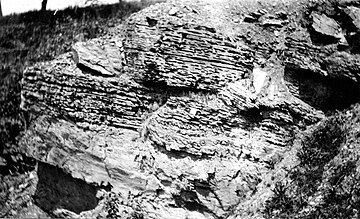
Middle Cambrian, depositional environment: deep water, outer shelf
Burgess Shale, British Columbia
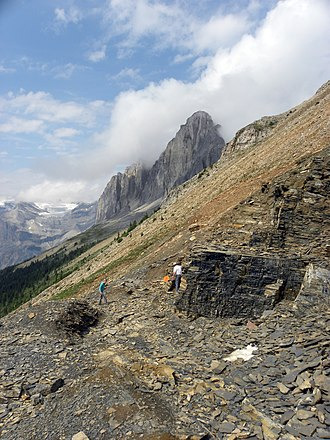
Middle Cambrian, depositional environment: below storm wave base
Spence Shale, Utah and Idaho

Middle Cambrian, depositional environment: continental shelf (both inner and outer).
Marjum Formation, Utah

Middle Cambrian, depositional environment: deep water.
Wheeler Shale, Utah

Middle Cambrian, depositional environment: below shelf where turbidites are deposited.
Weeks Formation, Utah

Middle Cambrian, depositional environment: gentle slope below the carbonate platform.
Maotianshan Shale, China
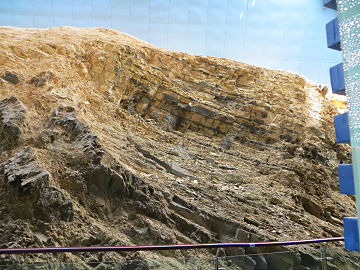
Early-Middle Cambrian, depositional environment: below turbidity currents where turbidites form.
Sirius Passet Formation, Greenland
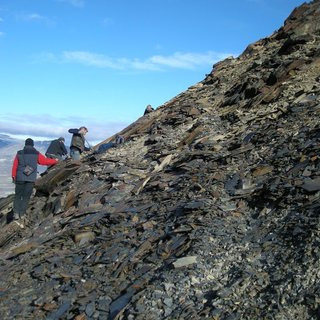
Middle Cambrian, depositional environment: slope below carbonate platform
Sinsk Formation, Russia

Early Cambrian, slope below carbonate platform
So, as we can see, most of these were formed in the Middle Cambrian below a carbonate platform or shelf also known as a reef. It would seem that if you want to be exceptionally preserved, live along the continental shelf slope and get buried in mudslides, or storm deposits.

Each of the red stars represents one of our lagerstätten. We can see that they were all within the tropics and all were on shallow continental shelves. Neat, huh?
7 notes
·
View notes
Text

a fossil a day keeps the sad vibes away
jawless fish friday?? can i get a shoutout to all the jawless fish? this guy is from the maotianshan shale beds and might be one of the first chordates, making them an ancestor to all vertebrates including you and me!
#fish#ichthyology#chordate#paleoart#paleontology#dinovember#dinovember2022#art#artists on tumblr#illustration#illustrators on tumblr#gif#procreate#mine#paleozoic pals#fossil art#digital art#palaeoblr
112 notes
·
View notes
Text
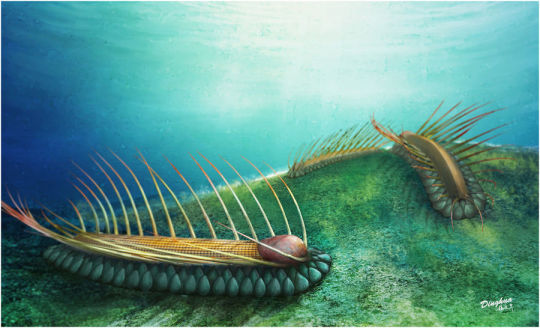
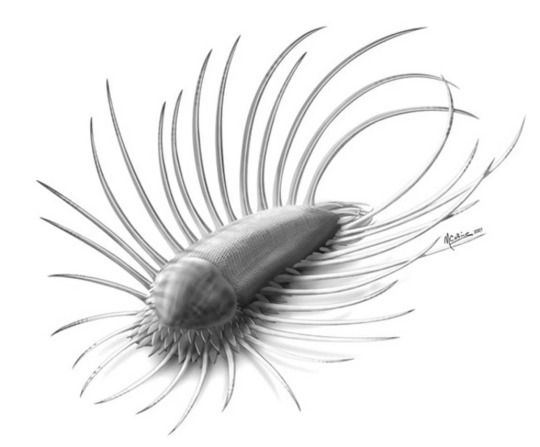
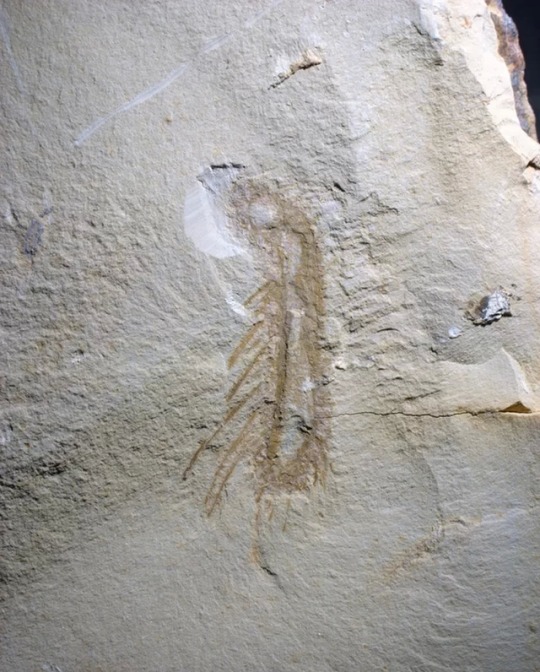
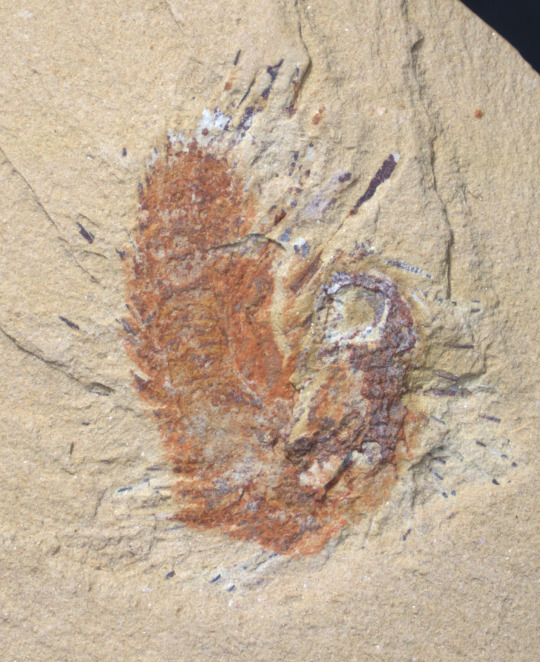
Orthozanclus
(size: 6 to 11 mm / 0.24 to 0.43 "; temporal range: 505 mio. years ago)
[text from the Wikipedia article, see also link above]
Orthrozanclus (from Greek ὄρθρος + ζᾰ́γκλος (órthros + zánklos), "dawn scythe") is a genus of sea creatures known from two species, O. reburrus from the Middle Cambrian (~505 million years ago) Burgess shale and O. elongata from Early Cambrian (~518 million years ago) Maotianshan Shales. Animals in this genus were one to two centimeters long, with spikes protruding from their armored bodies. The placement of this genus into a specific family is not universally accepted.
3 notes
·
View notes
Text

Cucumericrus
Cucumericrus — це рід ймовірних радіодонтів, відомий за кількома погано збереженими зразками знайденими в китайській провінції Юньнань у Сланцях Маотяньшань (Maotianshan Shales), що датуються середнім кембрієм. Були виявлені лише фрагменти кутикули тулуба та відповідних придатків, тоді як важливі ознаки радіодонтів, такі як передні придатки, у цього роду невідомі. Типовий вид – Cucumericrus decoratus.
Повний текст на сайті "Вимерлий світ":
https://extinctworld.in.ua/cucumericrus/
#cucumericrus#cucumericrus decoratus#yunnan#china#cambrian#cambrian period#maotianshan shales#paleoart#prehistoric#paleontology#палеоарт#палеонтологія#вимерлі тварини#extinct animals#ukraine#доісторичні тварини#made in ukraine#ukrainian#scientific illustration#science#history#nature#animals#prehistory#україна#український tumblr#український блог#українською#український пост#art
5 notes
·
View notes
Note
To step back millions of years ago: are there any difference in fossil Pokemon who originate from different geologic formations? Such as Kabuto from the Burgess Shale VS the Maotianshan Shales?
The fossil Pokemon present mostly depend on when the fossils were deposited and at what point in time - Omanyte fossils are typically older than Tyrunt or Amaura. The two deposits you mentioned mostly contain aquatic fossil Pokemon, so you can expect to find Kabuto, Omanyte, or Lileep in both.
14 notes
·
View notes
Text
'Strange beyond measure' sea creature unearthed in China

Archaeologists in China have discovered a fossilized sea creature that they describe as "strange beyond measure", with long spines along its worm-like body and a shell that covers its head, like a helmet.
The 515-million-year-old specimen was unearthed last year by a fossil collector in the hills of the Maotianshan Shales, an archaeological hotspot in Southwest China's Yunnan province.
The collector gave the fossil to Zhao Fangchen, a paleobiologist at the Chinese Academy of Sciences, who studied it, along with researchers from Durham University in the United Kingdom.
"The creature is like a mythical beast," Martin Smith, an assistant professor at Durham, told science news website Live Science. Read more.
220 notes
·
View notes
Link

Above: Brachiopod Larvae
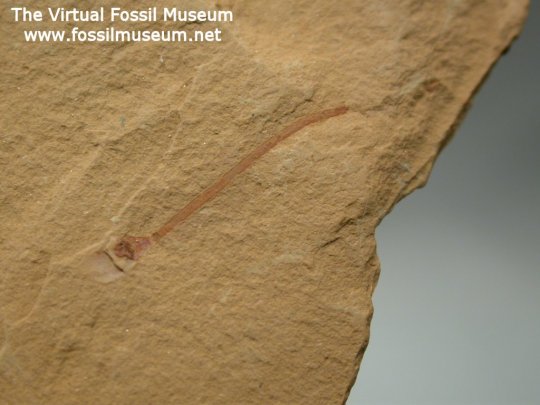
Above: 525 million year old Lingulella Brachiopod fossil from Maotianshan Shales of China, a member of the Cambrian Explosion fauna.
#science#evolution#teaching evolution#evolutionary biology#immune system#natural selection#cambrian explosion#fossil record#fossils
14 notes
·
View notes
Photo
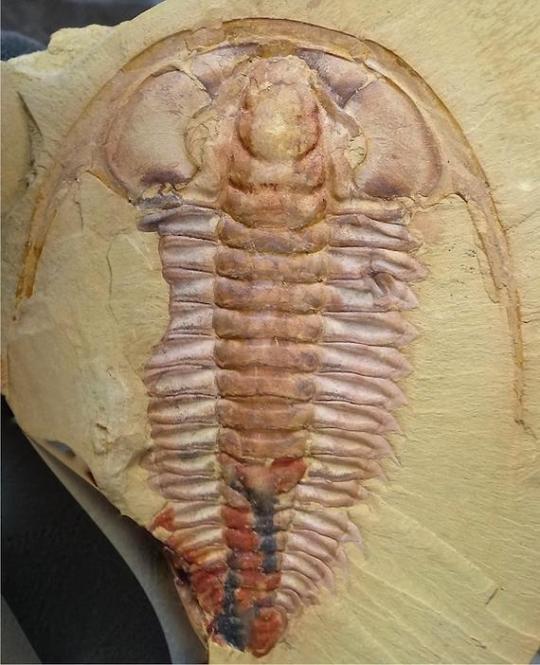
It's time for Trilobite Tuesday! In 1984, a thousand years after these layers were first noted by local residents, Chinese scientists formally described an amazing 515 million year old Lower Cambrian fauna located within the Maotianshan Shales of Chengjiang County in China's southern province of Yunnan. There, mixed amid a variety of primitive trilobite species including Eoredlichia intermedia (photo), Yunnanocephalus yunnanensis, Wutingaspis tingi and Kauyangi pustulosa, were an astounding assortment of soft-bodied creatures, many of which resembled those found in the legendary-- though 5 million years more recent-- Burgess Shale of British Columbia. Material from the Chinese site (which along with a number of other similarly-aged local layers, including the Chiungchussu and Qionzhusi formations, have become collectively recognized as the Chengjiang Biota) had been known as early as the 10th Century.
It wasn't until scientific expeditions began exploring the area in late 1970s, however, that research began to unravel the myriad scientific mysteries that lay within these 50-meter thick, hard mudstone layers. So far, 185 different species (with over half being arthropods… four being the aforementioned trilobites) have revealed themselves in the Chengjiang Biota, with the possibility that even more are still hidden within these ancient rocks, waiting to be discovered.
192 notes
·
View notes
Text
this is a continuation of this and is an ongoing choose your own adventure story. If it goes well, I'll do it again!
#Cambrian#Paleontology#Palaeoblr#Prehistoric Life#Maotianshan Shales#Palaeoblr Choose Your Own Adventure#polls
528 notes
·
View notes
Text
Episode 4: From Trilobites to Therapsids
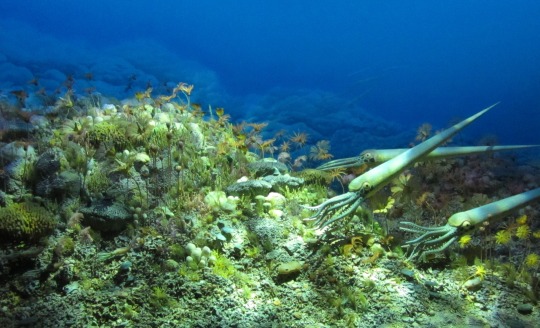
Image credit: Evan Howard, under CC BY 2.0. (cropped)
The following is the transcript for the fourth episode of On the River of History.
For a link to the actual podcast, go here. (Beginning with Part 1)
Part 1
Greetings everyone and welcome to episode 4 of On the River of History. I’m your host, Joan Turmelle, historian in residence.
The history of life on Earth is punctuated by several key themes. Throughout these next three episodes, I will be explaining the events that shaped the age of visible life, the Phanerozoic Eon. This time spans 541 million years, all the way to the present day, so this is the Eon to which we are currently in. You will notice that the evolution of living organisms is often regulated by the recurring fluctuations of a mostly oxygenated atmosphere and a mostly carbon dioxide atmosphere. You’ll also see that, despite the sheer horrors of mass extinction events, they are critical in shaping biodiversity. And, perhaps most crucial of all, the development of new features among groups of organisms is mostly a process of reshaping and recycling old things. In evolution by natural selection, you will never see a new trait forming out of nothing. Nearly always, new traits are developed in specific situations and only later find new uses as the environment changes.
The first era of the Phanerozoic Eon is the Paleozoic, or the age of ancient life. It lasted from the beginning of the Phanerozoic 541 million years ago and ends 251.9 million years ago. It was during this time that grand marine ecosystems developed and spread all across the globe, and living things spread out onto the land and made a home for themselves there.
The Paleozoic starts with the Cambrian Period (541 to 485.4 million years ago). Following a brief period when the fragments of Rodinia collided to form a new supercontinent called Pannotia, which itself split apart some 573 million years ago, the landmasses of the Earth were mostly collected into four continents. The largest, towards the south pole, was Gondwana. An expansive and long-lived continent, Gondwana includes regions that will eventually become Africa, South America, Australia, India, Madagascar, and Antarctica. Moving northwards from the south pole is Baltica, which includes most of Europe. Flanking Baltica is Siberia and Laurentia (made up of mostly North America). Two great oceans encompassed the continents, with the Iapetus Ocean separating Laurentia from Gondwana and the Panthalassic Ocean making up most of the northern hemisphere. Bordering the continents were an abundance of shallow seas, which acted as a cradle for the newly evolved animals.
As the Ediacaran faunas slipped away into obscurity, the descendants of the first animals diverged into two major groups based upon their mode of embryonic development. There is a process called gastrulation, where the growing bundle of cells collapses inwards on one side of its body and becomes the precursor to the gut. For most of the animals on one lineage, the protostomes, the opening to the gut became the mouth, and the exit-hole (the anus) opened later. For the members of the other animal lineage, the deuterostomes, the opening to the gut became the anus first, and the mouth came last. This seemingly trivial observation underpins most of the animal kingdom, and by the end of the Proterozoic Eon most of the major animal lineages had evolved.
The biggest key trait for the animals of the Cambrian was the development of hard skeletal parts on their bodies. Prior to these adaptations, most animals were soft-bodied and resembled worms. Around the beginning of the period, some lineages began to incorporate minerals like calcium and silica onto their bodies. This biomineralization is still poorly understood but has been hypothesized as tying to dietary needs. Some of the oldest fossils of hard-parts belong to the teeth of early worms like Protohertzina, that could have used their new adaptations to better grab prey items. In response, some organisms, like the early mollusks, developed hardened shells to protect themselves. One lineage of animals used calcium carbonate to stiffen their bodies and support themselves on the seafloor. Possibly related to sponges, the archaeocyathids formed symbiotic relationships with algae and bacteria that bound their cup-like bodies together, becoming the first reef-building organisms. As later animals, like true sponges and the ancestors of corals, refined their abilities to make hard-parts, they soon overran the archaeocyathids and drove the entire group into extinction.
As more and more lineages evolved hard internal and external skeletons, and the process became increasingly easier due to chemical changes in the oceans, animal diversity peaked in a grandiose display of unique and fascinating species 535 million years ago. This was the Cambrian Explosion, an event marked in the fossil record as the first time that organisms could really leave well-preserved fossils, as shells and skeletons tended to preserve better than soft-parts. That being said, there have been some spectacular fossils found in Cambrian deposits that have managed to preserve more easily decayable structures, like tentacles, internal organs, even skin pigmentation. These types of fossils seem to have formed through a rapid layering of clays that prevented the bodies of the different organisms from breaking down. Two sites stand out for their deposits, the Maotianshan shales of Yunnan, China, and the younger Burgess Shale of British Colombia, Canada.
With most of today’s animal lineages already established at the beginning of the Cambrian Explosion, much of their evolution during this time went towards the development of their primary modes of life.
Mollusks are among the most abundant animals in the oceans, rivers, and lakes of the world, but their evolution (like that of all major animal groups) began in the warm, saltwater seas off the coasts of the continents. The shells of mollusks serve as defensive structures that protect their vital organs from predators, and they themselves feed with a hardened and barbed tongue called a radula that scrapes edible materials from the surfaces of rocks. Cambrian mollusks came in a variety of forms, including the three majors groups: the valve-shelled bivalves (including clams, mussels, and oysters), the mostly coiled-shelled gastropods (snails and slugs), and the cephalopods (squids and octopodes) which gradually lost their shells.
Distantly related to mollusks are brachiopods. You’re probably not familiar with them, but during the Paleozoic Era they were one of the most common animal groups in the oceans. They look like clams but are actually very distinct in their anatomy. The valve-like shells of brachiopods cover filamented-tentacles that collect food particles from the water, and the shell is opened and closed by special muscles. Clams, like all bivalve mollusks, have a ligament that controls the movement of their hinged-shells, and they’re free-swimming organisms: brachiopods attach themselves to seafloor sediments by a long, flexible stalk.
Though well-adapted to their environment, mollusks and brachiopods were outnumbered by the arthropods, today the largest group of animals in the world. Ancestral arthropods used minerals to strengthen their entire bodies and developed an external skeleton or exoskeleton that preserved their internal organs. Unique for most animal groups was the evolution of jointed limbs, which could be adapted to a variety of different environments and lifestyles. Living arthropods include insects, arachnids, crabs, shrimp, and millipedes: some 80% of all animals. Who could guess that an exoskeleton and jointed limbs would prove to be such a successful adaptation?
The road to the arthropods was paved by many strange experiments in evolution, and the animals that underwent these changes belong to a larger group called Panarthropoda (named because it includes arthropods as well as their relatives). Genetic evidence and fossil remains show the earliest panarthropods as worm-like creatures, with stubby limbs and soft skins that probably walked along the seafloor or gripped onto sponges, like squirrels and monkeys in the trees. Today there are a few living descendants from these early groups, called velvet worms. Their soft skins leave them vulnerable to the elements, so they only survive in moist, tropical rainforests. One particularly curious member was Hallucigenia, famous among paleontologists because it was originally interpreted as a many-stalked animal that used rows of tentacles to grab food from the water. Later studies discovered that these researchers had accidentally been viewing the animal upside-down! It was an early panarthropod, protected from predators by a row of spines that grew along its back. The “tentacles” were actually its limbs.
Later panarthropods continued to strengthen their bodies with minerals and some adapted their limbs into paddles, allowing them to swim among the sponge reefs of the Cambrian oceans. They developed two appendages at the undersides of their heads that served as sensory organs and a few toughened those organs with hard teeth. One bizarre member of this group was Opabinia, looking like some Lovecraftian beast, shrunk down to a measly 2 and a half inches. It sported five eye-stalks and had one long flexible structure that ended in a little tooth-lined clasping grip, which it used to snag food and bring it towards its mouth (kind of like an elephant).
But the group that really dominated the Cambrian was the anomalocarids, which took up a wide range of niches. Niches are like occupations that organisms hold: the roles they play in different ecosystems. For example: a tiger holds the niche of apex predator in its habitat - nothing preys on it, but it alone sits at the top of the food web. Some anomalocarids may have filled the niche of apex ocean predator. There is some possible evidence that these panarthropods used their frilled appendages to grab soft-bodied prey and direct it towards a circular mouth, lined with teeth-like projections. But many members of the group were filter-feeders, with their appendages lined with long bristles for collecting food particles, like the baleen whales of today. Though they were the largest animals in the Cambrian, anomalocarids appear to have mostly died off by the end of this period, with evidence that a few species clung on for another 100 million years before going extinct.
Proper arthropods fully divided their bodies into segments, each sporting its own pair of jointed limbs. These animals divided into two major groups: mandibulates, with paired antennae and chewing mouth parts, and chelicerates, lacking antennae and having shredding mouth parts. Mandibulates include insects, crustaceans, and myriapods (millipedes and centipedes); chelicerates include arachnids and horseshoe crabs.
The highlights of the Cambrian Explosion (and really the stars of the Paleozoic Era) were the trilobites. We’re not sure what kind of arthropods they are, but that’s really the only major mystery of this now extinct group. Their woodlouse-like fossils are so prevalent, and their record so complete, that we have a good idea how they lived, what they ate, and what their reproductive cycle was like. The name means “three-lobed” and refers to the general structure of their exoskeleton: a cephalon or head, a thorax, and a pygidium or tail. They came in a variety of different body forms, including species with spines, species with enormous eyes, and species with thin bodies. There were free-floating planktonic forms and trilobites with eye-stalks that probably hid under the sand, but most trilobites appear to have been grazed on particulate food. The largest species grew to the size of bed pillows, large enough to eat other trilobites. In the Cambrian Period, they were the most common and most successful of the newly evolving animals.
The previously described animals were all protostomes, but deuterostomes had also expanded in diversity. One prominent group in the oceans were the echinoderms, who incorporated minerals into a strong but flexible inner skeleton or endoskeleton. A series of tubes stretches through their bodies and helps these animals breath, move, and feed. Echinoderms today include sea stars and urchins, and the earliest members of the group were mobile organisms. However most Cambrian echinoderms appear to have been filter-feeding, stalked animals, attached to the ocean floor. Other deuterostomes include the hemichordates, which were worms that supported their bodies with a long nerve cord and breathed through gill slits at their front ends.
Perhaps the most important group to animals such as ourselves are the chordates, because this is the lineage that humans and all other vertebrates belong to. Ironically enough, chordates did not play a large role in the Cambrian oceans, and as a whole they were probably uncommon in their ecosystems. Like hemichordates, chordates have gill slits and a nerve cord that runs through the body, but in this group the cord became supported by a rod stiffened by cartilage, the notochord. Also prevalent is a tail that helped these deuterostomes control their movement as they swam through the seas. Some of these chordates retained these ancestral traits and buried themselves into coastal marine sediments, becoming the lancelets. Others hollowed out their bodies and some of those secured themselves to rocks, becoming the sea squirts and salps. The ancestors of vertebrates developed early in the Cambrian Period, around 530 million years ago. Particularly good fossils from the Maotianshan shales of China show that two early vertebrates - Haikouichthys and Myllokunmingia – had encased their brains in a skull and sported small vertebral elements around their notochord. These were not true bony vertebrae, but from these ancestral forms onwards there is a marked increase in bony hard-parts throughout the body. Animals like these were very fish-like, and for all intents and purposes could be called the earliest fishes.
By the end of the Cambrian Period, the abundance of minerals in the shallow seas changed nearly all of the major animal groups alive today, and in turn, they began to change their ecosystems as well. Prior to the Cambrian Explosion, much of the seas were covered in mats formed by microbial colonies, including those of cyanobacteria. With the rise of grazing animals like mollusks and echinoderms, these mats began to face decimation as the new animals feasted on them. As a consequence, these mat-forming microbes began to move deeper into the oceans and higher onto surface rocks where these newly-evolving animals could not get them.
Roughly 499 million years ago, deadly hydrogen sulphide levels rose and oxygen levels depleted in shallow marine waters and caused many different species to go extinct. Trilobites were severely affected, as were many unique forms of animal life. It is unclear what set off this change in ocean chemistry, but it set the conditions for new animals to evolve.
Part 2
The Ordovician began 485.4 million years ago and ended 443 million years ago. The massive continent of Gondwana moved slowly southwards and the remaining landmasses of Laurentia, Siberia, and Baltica gradually began to move towards each other. Small island continents slowly collided with Laurentia to the south and produced the first stages of the Appalachian Mountains. This continental drift caused the Iapetus Ocean to widen slightly, and there were still extensive shallow seas where large collections of sediments eroded into their waters. Like the period that preceded it, the Ordovician was mostly a hot, tropical world.
These warm oceans, now bounced back from their previous chemical changes, had many marine niches left open for species to fill. On top of that, the rise in minerals from erosion produced a bloom of planktonic organisms. There is a marked rise of fossils featuring new groups of animals during the beginning of this period, with the number of species tripling from previous levels over a 25 million-year timespan. This led paleontologists to coin a name for this time: The Global Ordovician Biodiversification Event. The animals that evolved during this period were to set the standard for marine faunas for the duration of the Paleozoic Era, and introduced a number of new modes of living. For the first time, animals began to make greater journeys out into the open ocean and some groups of mollusks and worms started burrowing deeper and deeper into the seafloor.
Reefs expanded in great numbers during the Ordovician, and the main builders during this period were a group of now-extinct sponges called stromatoporoids. They were originally thought to be types of corals because their skeletons were made of dense calcite minerals, much tougher than sponges nowadays. But they were not the only encrusting marine animals around. One of the last major groups of animals finally evolved in the Ordovician: the bryozoans. Sometimes called moss animals due to their superficial similarities, bryozoans live in hardened colonies that grow on rocks or the shells of animals. Each colony is made up of several tiny creatures with little tentacles to filter-feed with. Their numbers were significantly greater in the Paleozoic, but living species are not as common as other colonial animals like corals.
The major groups of mollusks continued to diversify, and the bivalves came into high prominence during the Ordovician. Like the unrelated brachiopods, bivalve mollusks have valved-shells (that’s where they get their name), and they’re filter-feeders, but rather than use filamentous tentacles to catch food, bivalves have plates of gills inside their shells, all lined up like a stack of paper. While the brachiopods controlled the deeper regions of the seas, bivalves were more content in nearshore waters where they didn’t have to compete for the same resources. Gastropod mollusks were doing well too, and a few of the dominant lineages evolved in the Ordovician, including the ancestors of limpets. Limpets have survived into the present day and their anatomy is remarkably ancient, lacking the coiled shells of their later relatives. Nonetheless, the conical shells of limpets are excellent adaptations: the animal can stick itself to rocks and completely cover its body with a tough exterior that most predators have difficulty with.
The heavy-weight champions of the Ordovician were the cephalopods. Although the majority of species today have reduced or lost their shells altogether, the earliest groups had spectacular shells. One lineage, the endocerids, could grow their shells up to 19 feet in length, making them the largest animals in the world at the time. They have been suggested to be major marine predators, using their tentacles to snag prey items, but it is equally possible that some species were filter-feeders. In any case, they would have been awkward animals to look at; because their giant shells were full of empty spaces the center of gravity would have made them float vertically in the water, with their tentacles facing downwards, like living icicles.
Despite their losses during the Cambrian extinction event, trilobites managed to bounce back and became more diverse than ever. Great swarms of them roamed the seabed, feeding on all sorts of organic materials. Some groups when threatened by predators could roll themselves up into a ball, using their head and tail to completely protect their soft undersides and legs, while other species used their spines for defense. There were plenty of new arthropod predators in those days, with the earliest eurypterids evolving 460 million years ago. Though they look like giant marine scorpions (and are commonly called sea scorpions), eurypterids were only distantly related to arachnids. Nonetheless, some species possessed scorpion-like pincers for snipping at prey, and one kind called Megalograptus had a spike at the end of its tail – though there’s no evidence that it was venomous. Crustaceans too were beginning to diversify. The first ostracods and branchiopods evolved: these are small-bodied animals that swim through the water with their arms or antennae. Ostracods are mostly microscopic and planktonic animals, but branchiopods are perhaps more familiar due to two major lineages: the water fleas and the brine shrimp (popularly marketed to children as ‘sea monkeys’).
All of the surviving lineages of echinoderms evolved during the Ordovician Period, including the first sea stars, brittle stars, urchins, sea cucumbers, and crinoids. Among these groups the crinoids are the least common in modern times, but during the Ordovician they were remarkably diverse, growing in groves around calm, shallow seas. Crinoids attached themselves to the ocean floors on long stalks and sported a comb of filter-feeding tentacles atop their heads. They shared their world with other long-gone lineages, including the blastoids, who looked like crinoids but had very pentagonal heads. A new lineage of hemichordates developed that were to become the dominant planktonic animals of the early Paleozoic: the graptolites. Despite their relation to the living worm-like species, graptolites were remarkably different. They were tiny colonial animals – like bryozoans – that lived in hardened tubes that simply floated along ocean currents. These tubes, made of proteins, often sported beautiful patterns and shapes, with some graptolites resembling fans or coils, and others lining their tubes with rows of spines or branches.
The vertebrate story continued at a slow pace. By the Ordovician, fish had evolved proper bones and covered their bodies in scales, and the majority of species had gone a step further and strengthened their scales into solid armor. Like most of the other animal groups, these would have proved to be a great defense against predation. However, fishes still remained a small part of the ecosystem. They were not apex predators, for they still lacked jaws and could only suck up soft-bodied food from the seafloor, and they did not venture out into the open oceans either, with all species remaining in shallow seas and along coastlines and estuaries.
The earlier development of the ozone layer proved to be a beneficial aid to life on Earth, allowing so many different marine organisms to thrive in the oceans, but for the first time ever, life began to colonize the terrestrial world. Up until the Ordovician, the only types of plants were marine species of red and green algae. The only land-living, photosynthetic organisms were the mats of cyanobacteria that moved onto surface rocks to escape the threat of grazing animals. Analyses on living species of green algae suggest that the first land plants developed from freshwater species and survived on land because they adapted their bodies to become waterproof (which prevented them from drying out). Fossils from 473 million years ago show plants very much like liverworts, which are the oldest surviving group of land plants today. Liverworts do not have roots or stems, but instead attach their flattened bodies called thalli to the ground. Like their algal relatives, liverworts and other early land plants reproduced with spores, which the adult plants release into the water where they land and grow into copies of their parents. This meant that, despite their terrestrial existence, the first land plants were restricted to warm, moist environments.
But they were not alone in their travels, because they were soon followed by the earliest land fungi. Fungi had already been around on Earth since the Proterozoic, making up on of the major groups of eukaryotic organisms. In fact, they are more closely related to animals then they are to plants, meaning you have more familial relations to the mushrooms in your soup than to the carrots or onions. Fungi are mostly decomposers: breaking down dead materials that provide them with nutrients. They had a ready food source when the first land plants began to die, and through their decomposition process they began to churn parts of the sediment, creating soil. All land plants today rely on soil for nutrients, so newly growing spores were treated to an increasingly safer environment, thanks to the fungi. Ever slowly the stage was set for the rise of terrestrial environments, as vast numbers of liverworts blanketed the margins of freshwater rivers and lakes.
The good times were not to last, as the Ordovician closed with a major mass extinction event. While the direct causes are still debated by researchers, the changing conditions at the time almost certainly put pressures on marine organisms. Analysis of rock formations around 450 million years ago demonstrate that carbon dioxide levels plummeted, while oxygen levels increased dramatically. As Gondwana moved south and covered the poles, the Earth became cool enough for glaciers to form there, which expanded and took in such large amounts of water that the sea levels dropped. Many of the warm, shallow marine environments were lost as a result, and as much as 86% of marine species went extinct. Yet again, the trilobites took some serious damage and their numbers never recovered to previous levels; and there were great losses of brachiopods, bryozoans, and graptolites. What happened to all the carbon dioxide? Hypotheses blame the drop in levels due to the rise of the first land plants, because their sheer numbers on land may have photosynthesized a little too well. Other evidence points to volcanic weathering causing the drop in carbon levels; remember, weathering of certain rocks often takes up carbon dioxide. The ice sheets at the south pole were at their greatest extent during the last seven million years of the Ordovician, but when the period ended much of the marine life in the oceans was gone.
The Silurian picks up where the Ordovician left off: a relatively short geologic period from 443.8 million to 419.2 million years ago. As the Earth’s overall climate warmed up again the glaciers began to recede in Gondwana, and the sea levels rose. The giant continent itself started inching northwards. By now, Laurentia and Baltica had connected together as one landmass called Euramerica, due to the inclusion of lands that would eventually become Europe and North America. Siberia remained isolated, and the Iapetus Ocean began to close as Gondwana and Euramerica moved closer to each other.
As it had done after the Cambrian, marine life rebounded following the Ordovician, but now there were depleted stocks. Trilobites and graptolites lost much of their diversity, and the great sponge reefs had lessened in number. In their place emerged two types of stony corals that had evolved quietly during the Ordovician. The first group and the ones that primarily formed the new reefs were the tabulate corals. They were colonial organisms, like living corals, and formed flattened, table-like structures in great quantities. Among them was the second group, the rugose corals, who could form colonies or remain as single organisms. Their bodies looked like horns, but they often angled themselves in their growth. Surprising as it may seem, corals are related to sea jellies: whereas sea jellies adapted themselves to be free-floating animals, corals flipped that body plan over and resided to an existence attached to rocks and seafloor sediments. These new coral reefs became great templates that supported a wide variety of animal life.
The iconic invertebrates of the Paleozoic, the giant cephalopods and frightening eurypterids, continued to stalk the oceans. Among the mollusks, the bivalves managed to radiate into a great number of new groups, given that their main competitors the brachiopods faced such heavy losses at the end of the Ordovician.
Fish became big winners during the Silurian Period, thanks to the evolution of true jaws. Given that the first fishes were jawless animals, how did this adaptation come to be? Genetic and anatomical evidence points to a change in development of the front most gill arches (the parts of the throat that provide support for the gills themselves). These migrated towards the exterior of the mouth and allowed that part of the body to close and open at will. Given that gills help fish take in oxygen from the water, this ability to work the mouth would have helped them take in more water (this feat is called buccal pumping). These ancestral jawed fishes could effectively breath faster than their contemporaries and as a result could swim better too. Over time, this adaptation found another function, fish that had strengthened the repurposed gill arches could now catch and kill prey with their mouths more efficiently. New dietary options opened up, and now the fishes of the Silurian could eat each other! The gill arches became true jaws. This remarkable change in physiology prompted the evolution of all the major groups of jawed fishes, and as a result, the jawless fishes were now about to face some serious competition.
The situation on land grew much more serious. As collections of plants and fungi changed the surfaces of freshwater coasts, new plants evolved to join their number. Among the liverworts were the first mosses, which had special structures called rhizoids that gave them some anchorage to the soil. New plants evolved later on, around 433 million years ago, that underwent significant structural changes to their bodies. These were the vascular plants, so named because inside their revolutionary new roots, stems, and leaves was a system of vein-like tubes that could take in water and nutrients and distribute them through their body. This was a more efficient system than what the liverworts and mosses had, because it meant that vascular plants had more strength to support their bodies in the gravitationally-dominant environment. One of the icons of Silurian botany is Cooksonia, which was one of the most common land plants at the time. They were relatively tiny plants, only growing as high as 2 inches, that had a Y-shaped prong structure. At the end of these prongs were their spores, which they could release into the wind. At the other end of the plant spectrum is Baragwanathia, which was among the tallest plants on land (growing up to 11 inches high). These plants were lycopods, one of the surviving members of this new flora that can still be found today. They’re distinguished among their peers by their covering of tiny leaves all along their stems, which increased their surface area and allowed more sunlight to be captured. Traits like these allowed lycopods and other vascular plants to outgrow their competitors and really change the landscape.
But the plants and fungi were no longer alone in their world. Fossil evidence indicates that for the first time, animals began to make serious trips onto the land. Prior to the Silurian, there is some fossil evidence that certain creatures were making small visits to the sandy coasts: for example, trackways have been found that have been identified with eurypterids and aquatic myriapods like millipedes. But these animals could not have permanently stayed on land because they still breathed with gills and so they had to return to the water to survive. Arthropods that managed to survive on land had underwent mutations that changed their bodies. The first land arachnids developed book lungs that were retained inside the body and took in oxygen from the air instead of water. Other arthropods like mandibulates switched out gills for a series of spherical holes along their bodies, connected to an interworking system of tubes that carried oxygen everywhere. Among all members of the group, their jointed limbs proved to be helpful in supporting their weight as they roamed the soils. By the end of the Silurian, arachnids (in the form of scorpions and a now extinct group called trigonotarbids) and myriapods (in the form of millipedes and centipedes) established a presence of land. With new resources like plant matter, some arthropods developed into herbivores, while others took advantage of the new prey items and remained carnivores. It is even possible that the ancestors of earthworms and nematodes were living on land at this time, though their soft-bodies would have not preserved well in these conditions. Thus, the first land ecosystems and food webs were in place.
Part 3
The Silurian Period passed calmly into the Devonian Period, 419.2 million to 358.9 million years ago. As Gondwana moved northwards it started to rotate as the lands that would become Australia and China began to move towards Siberia. Euramerica made contact with Gondwana by the middle of the Period, closing the Iapetus Ocean forever. This collision of continents pushed up great mountains along the connected landmasses: these were the precursors of the Caledonian Mountains, which today can be found along Greenland, Scandinavia, and the British Isles. This mountain building also helped push the Appalachians higher. The glaciers that dominated the south pole in the Silurian had receded significantly till they were almost nonexistent. Carbon dioxide levels rose, and the world became much warmer and dryer.
While tabulate corals were still doing well during the Devonian, the rugose corals increased in diversity and joined their relatives as the main reef-building organisms. Brachiopods and crinoids continued to filter-feed among the reefs, while eurypterids decreased in overall importance in marine ecosystems. Among the crustaceans, the earliest decapods evolved, which sport ten legs. The ancestral body plan of the first decapods was very shrimp-like, and indeed shrimp and prawns belong to this group (though these are interchangeable terms for the same animals that lack any scientific basis). More prominent members of the decapod group, like the crabs and lobsters, didn’t evolve until much later in the Mesozoic Era. The mollusks themselves also gave a world a new lineage of cephalopods, with strong sutured shells that formed coils. These were the ammonoids and they became predatory mollusks, unlike their filter-feeding relatives the endocerids (which, incidentally, died out during the Silurian).
The ammonoids and decapods proved to be very special organisms, because they featured in a remarkable adaptation event called the Nekton Revolution. Paleontologists coined this term to refer to a change in the fossil record when many organisms began to adapt to a swimming lifestyle. To be nektonic is to be free-swimming. Now more and more animals were occupying niches in the open ocean, and the seas began to crowd with an abundance of different organisms.
The fish, which had already developed into their main groups, were now diversifying into different forms and taking advantage of the new niches that were being created: it was the Age of the Fishes. One group of jawed fishes called antiarchs converted their front fins into hardened plates and moved their eyes to the tops of their heads, possibly helping them move along the seabed and bottom-feed. Another lineage, the chondrichthyans, made their internal skeletons cartilaginous (that is, made of cartilage instead of bone), which lightened their weight and made them faster and more efficient predators. This paved the way for the first sharks. It’s often been said that sharks have remained unchanged since the Devonian, but a quick glance at the fossil record debunks this: most of the early sharks of the Paleozoic were strange and weirdly-shaped animals, one example being Sethacanthus which sported an anvil-shaped growth at the top of its back that paleontologists have had difficulty explaining. Modern-type sharks won’t evolve for a long time. But the most spectacular of all the fishes in the Devonian were the arthrodires, who strengthened their heads and jaws with thick armor plating. The biggest members of the group included the open-ocean filter-feeder Titanichthys and the apex predator Dunkleosteus, both reaching lengths of up to 33 feet. With the rise of jawed fishes like these, nearly all marine ecosystems from the Devonian to the present day had vertebrate animals as their main predators.
Among the bony fishes stemmed two kinds. There were the ray-finned fishes or actinopterygians that trading in their fleshy front fins for a webbed-ray of bony or cartilaginous spines. In the present day, most fish species belong to this group. The other group of bony fishes kept their fleshy-fins and developed a lobed-anatomy where the fins encased a series of bones. These lobe-finned fishes or sarcopterygians are vital to the story of our evolution, because it was from this group that the ancestors of land vertebrates originated. How did this remarkable transition from aquatic animals to land animals take place?
The current fossil evidence we have points to the bony fishes of the Devonian evolving along seashores and coastal environments. Most of the lobe-finned fishes were finding food in estuaries and freshwater rivers. They were not particularly fast vertebrates, and they didn’t need to be, as they did not face any of the pressures of open ocean living that their relatives the ray-finned fishes faced. By growing out the bones in their fins and creating a wrist joint, sarcopterygians could skulk about the riverbed or cling to aquatic plants. Over time the fins became more flexible and more joints developed: from ankles to elbows. Now the sarcopterygians had proper limbs that allowed them to better move through their freshwater environment. But at the same time, this anatomy proved beneficial when a few of these fishes started making temporary journeys onto the shores in search of food, as there were plenty of arthropods already there. Repeated trips caused their skeleton to strengthen and become more flexible. The hip bones adjusted to the hind limbs and gave them more support, while the shoulders separated from the ribs to aid with steering the body. A neck formed, and some of the bones of the limbs moved outwards and formed digits. They could breathe the air with lungs and collect oxygen from the water with gills. It’s important to state that fishes ancestrally had air sacs: ray-finned fishes modified them into swim-bladders to aid with buoyancy, while lobe-finned fishes developed them into proper lungs. The stegocephalians had arrived, spearheaded by the appearance in the fossil record of forms like Tiktaalik, Acanthostega, and Ichthyostega. While these fishes were capable animals on land, able to shuffle along the sands and silts like seals and mudskippers do today, they were primarily aquatic and still gained most of their resources in the water. But it was a capable start of things to come.
The land became a truly inviting place during the Devonian. Liverworts, mosses, and lycopods blossomed into a number of larger forms, and they were joined by a host of new vascular plant lineages that grew into complex branching forms with the first proper leaves. Monilophytes – the group that includes the ferns and horsetails – gave their roots the ability to spread out and form new copies of itself. Because these structures form underground, they can allow monilophytes to survive in harsh conditions, meaning that the earliest ferns and horsetails were able to spread out farther than other plants previously could. Another lineage of vascular plants went from using spores to dividing their sex cells into different structures, with the female sex cells staying in the parent plant and the male sex cells needing to be dispersed as pollen grains. This simple adaptation allowed these plants called spermatophytes to increase their genetic diversity and their range of distribution, because now pollen could be carried further by the wind. Not only that, once the two sex cells met and formed an ovule (or egg), special cells were directed to form a hard outer layer around it. This shell enclosed a wet storage of food that sustained the embryonic plant until it could be planted somewhere else. This is how seeds formed, and fossils of Devonian plants called Elkinsia and Runcaria reveal this process in action. In the meantime, some of the members of the monilophytes and seed plants started to grow more and more vessels for transporting water up their stems. These structures were formed by an organic molecule called lignin, which itself was encased in another organic molecule called cellulose. Following generations of growth, the lignin-cellulose outer-layers of plants strengthened and hardened and gave rise to the first plants with woody stems. Wood is a tough material and it allowed plants to rocket to the skies: the first trees had evolved. Understandably, they started out small, but soon towered over their neighbors: one of the oldest trees, Wattieza, was 26 feet tall. With the evolution of seeds and wood, plants spread much farther from the waters than they ever could before.
Arthropods and mollusks flourished in the growing forests: the earliest mites, spiders, and harvestmen, accompanied by the first air-breathing snails. Insects begin their story in the Devonian, having evolved from freshwater crustaceans related to branchiopods in the Silurian. These hexapods, as their name suggests, developed a body plan with six legs. Some of these early hexapods adapted their tails to act as ‘spring-boards’ that could propel them away from predators. They survived to the present day, earning their common name springtails. The first insects distinguished themselves by growing larger and moving away from the underground, moist environment of their ancestors. They became herbivores, ingesting the leaves and stems of the new plants that were evolving. Like the springtails, remnants of this time still exist today in the form of the soil-living bristletails and those domestic pests the silverfish.
Right around the end of the Devonian struck a series of mass extinction events. The expansion of terrestrial plants with deep, piercing roots seems to have allowed great quantities of soil nutrients to wash away into the rivers and seas, causing oxygen levels in the water to decrease. This eutrophication would have caused vast regions of the seas to become anoxic and deadly for living things. It was a particularly damaging collection of extinction events: estimates place the loss of marine groups at 40-50%. Some of the organisms that were still recovering from their losses in the Ordovician, like the trilobites and brachiopods, were hit hard. In fact, all but one lineage of trilobites was wiped out. The graptolites, that curious lineage of hard-shelled, planktonic worms, vanished from the Earth, as did many unique forms of echinoderms and most of the newly-evolved ammonoids. The great reefs of tabulate corals and sponges met their end, leaving those organisms relegated to lesser roles in the ecosystem. The Age of Fishes ended with losses too: all of those weird and wonderful jawed fishes, the arthrodires, the antiarchs, and others, died in the low-oxygen oceans. Jawless fishes saw most of their number go extinct, leaving two lineages of worm-like animals, the hagfishes and the lampreys, to go on to present times.
Part 4
So the world entered a new period, the Carboniferous, from 358.9 million to 298.9 million years ago. Euramerica and Gondwana remained connected as a giant continent, but by the middle of the period those pieces of Gondwana that would go on to form the lands of China had collided with Siberia. In turn, these ancestral Asian lands pushed against Euramerica and rose up the Ural Mountains. A vast expanse of water was opened, creating a new ocean called the Paleo-Tethys. Parts of Gondwana still hovered over the south pole, and the small glaciers there slowly began to grow again. At the western edge of Euramerica, the Rockies were beginning to raise.
But the primary modifiers of the Earth’s land and climate would prove to be the living things that resided upon it. The seas of the world were much reduced in diversity following the Devonian Extinction Events, and for a period of time there were no major reef-building organisms. The rugose and tabulate corals were still around – in lower numbers – but they did not form reefs. In their place emerged great forests of crinoids, those stalked echinoderms that filter-feed through the water. Often termed ‘meadows’, these expanses of crinoids grew and died in such rapid succession that they formed deposits of limestone.
On land, the foundations of the world’s coal deposits were developing. As plants continued to evolve and spread across the land, great forests grew and went on to cover much of the available land. New species of trees evolved among the vascular and non-vascular plants. Some kinds of lycopod, like Lepidodendron and Sigillaria, could tower 130 feet in the air and sported scale-like bark. There were giant horsetails too: Calamites reached up to 66 feet high and in some cases had stems 24 inches thick. Tree ferns were present and seed plants also produced enormous forms, like the 148-foot high Cordaites. As you can see, giant trees were the norm in the Carboniferous. There were so many tough, woody plants around, but nothing to eat them. Despite a patchy fossil record, we can be confident that wood-eating bacteria and fungi had not evolved yet because of how these trees ended up dying. When they eventually dropped to the ground, rather than decompose, the trees got covered up by swampy sediments. Over time, the remains of the trees piled on top of each other, and millions of years of heat and pressure from the Earth’s surface converted the biological remains into coal deposits. The most prominent remains of coal come from Carboniferous rocks, which is what gave the period its name: due to the lack of decomposition, all the carbon that the plant took in is still there. Keep this in mind for later.
With so many forests on the land, carbon dioxide levels plummeted while oxygen levels rose significantly: over 30% above present day levels. In turn, the presence of so much oxygen in the air (plus the fact that wood now existed) meant that passing lightning strikes could spark fires for the first time. All this oxygen had another adverse effect on animal life too.
Due to the way arthropods breathe, the more oxygen is available to them, the larger they get. This period of Earth’s history is famous for its abundance of seemingly-improbable giant arthropods. The myriapods begat the giant millipede-relative Arthropleura, an herbivorous species that grew over 7 feet long. There were massive three-foot scorpions roaming the coal forests, preying on the hordes of new terrestrial species. And insects truly began to diversify during this time. The key adaptation that marked the path for the insects was wings. While still a controversial discussion in paleontology, genetic and morphological evidence has suggested that the precursors of insect wings developed from gills that became repurposed for movement in air rather than water. The first wings were stiff structures that were held outwards from the body, and these were found in the first mayflies, dragonflies, and damselflies. Relatives of these insects, the dragonfly-like griffinflies were among the giant arthropods of the Carboniferous. The wingspan of one called Meganeura reached 26 inches meaning that it would have been a formidable aerial predator. Later insects modified their wings to fold inwards towards their bodies, and this proved to be a beneficial change because it meant that these delicate structures could be protected from wear and tear. By the end of the Carboniferous, the ancestors of grasshoppers, cockroaches, lacewings, and beetles had made a home for themselves in the coal forests.
Stegocephalians remained mostly aquatic animals for most of the Carboniferous, but a descendant branch of this group, the tetrapods, began to diversify into a myriad number of lineages. Tetrapods are proper four-limbed vertebrates that all (at least ancestrally) retained five digits on each foot. One group, the temnospondyls, produced crocodile-like forms that lurked in the swamps and fed upon large aquatic animals. It is among the temnospondyls that we find the ancestors of true amphibians, who retained an aquatic larval stage. Other tetrapods formed lineages that did not survive the Paleozoic, including worm-like animals that lost their limbs. The most significant development in the vertebrate story was the amniotic egg, where the embryo is stored with water and nutrients inside a hardened shell that could be laid on the land, rather than in water. With so many opportunities for predators to feast upon the jelly-like, soft eggs of their predecessors, this adaptation meant a better chance for survival. So the amniotes evolved to become proper terrestrial animals, able to survive away from the water and take on the newly emerging ecosystem that is the land. As a consequence of living in a dry world, amniotes developed toughened, water-proof skins and claws on their digits allowed them to better maneuver over rough surfaces or brush. By the end of the Carboniferous, two lineages of amniotes had evolved, becoming the two great groups of land vertebrates: the sauropsids or reptiles, and the synapsids, the ancestors of mammals. The two groups are distinguished by the placement of holes behind the eye socket that aid with jaw-muscle attachment. Reptiles typically have two holes behind their eye socket, while synapsids have just one. And there were herbivorous and carnivorous species that played vital roles in their food webs.
The Carboniferous was a dramatic time for life. The effects of the coal forests proved too great for the planet, and the resulting losses of carbon dioxide and gains of oxygen caused the Gondwanan glaciers to grow in size until they expanded across the continent. The climate cooled and caused many of the forested swamps to fragment in size or die off altogether. Wetland-adapted tetrapods died off in huge numbers and many of the giant lycopod trees perished as well. It was the hardy plants and animals that took over their ecosystems. Ferns and seed plants expanded their range and formed vast swaths, and the amniotes diversified in the new drying world. This glaciation was short-lived, but of course that meant that its effects put greater pressure on life as a whole.
The final period of the Paleozoic Era was the Permian, 298.9 to 251.9 million years ago. The Gondwanan glaciation ended during the early part of this time, around 280 million years ago, and the levels of carbon dioxide rose again. The famous supercontinent of Pangaea formed during this time, as the Gondwana-Euramerica landmass collided with Siberia and the other continents. This meant that, had our modern borders been present at the time, you could walk from Sumatra to Argentina without ever needing to cross a body of water. With the shrinking of the coal forests and the rise of upland, terrestrial ecosystems, vast parts of the land were not in contact with any river or coastline and they subsequently dried up and formed deserts and scrublands. Thus, the Permian was a hot, dry planet, but one populated by animals and plants that could withstand it.
Marine faunas bounced back slightly, and sponges once again took the helm as the main reef-builders. Brachiopods and bryozoans managed to do very well and were common animals in the seas, while the trilobites were few and unimportant. Ammonoids regained their former numbers. The diversity of fishes, while much reduced from their Devonian days, was still high, and there was even room for experimentation. A relative of sharks and rays, Helicoprion, sported a strange coiled row of teeth in its mouth and this baffled paleontologists for years because no one knew where exactly it was supposed to go. Reconstructions abounded, with some placing the whorl at the front of the jaws and some placing it deep in the throat. The most recent interpretation, based on better fossils, finds the tooth whorl in the center of the lower jaw where it stuck out awkwardly.
Alongside the ferns grew newer kinds of seed plants. Gymnosperms did remarkably well in the drier parts of the land, with the first cycads and ginkgoes taking root in the sands. Conifers (represented today by species like pine, spruce, and fir) had evolved in the Carboniferous, but they flourished during the Permian. Despite all this diversity, the most common tree in the world was not a conifer but a seed-bearing plant called Glossopteris. What made this plant so hardy was ability to cope with colder environments, including mountain ranges.
Tetrapods roamed over the warmer and wetter regions of the planet, with giant temnospondyls sharing the swamps, lakes, and rivers with equally giant predatory lobe-finned fishes called rhizodonts. The stars of the Permian lived on land, however. The amniotes spread out far and wide over the Pangaean supercontinent and took on nearly every niche and body type available. Among the reptiles were the first land vertebrates to return to an aquatic existence, with later varieties occupying more of an amphibious niche: periodically switching between land and water. Some reptiles took to the air, developing membranous structures along their sides for short gliding. The earliest ancestors of turtles appear to have lived about this time, too.
Most of the apex predatory and herbivorous niches went to synapsids, who often were the largest animals in their ecosystem. The earliest synapsids were lizard-like animals, that walked with a sprawling gait and had an ectothermic physiology, gaining heat from their surrounding environment for metabolic functions. Included among these ancient synapsids is Dimetrodon, which sported a row of spines along its back that were encased in webbing. It was originally thought that structures like these aided in their ectothermy, with excess heat being released by the sail while winds that blew on it cooled the animal, but recent studies now dispute this: it just doesn’t seem to work like that. Newer studies have shown a role of the sail in courtship displays, meaning that Dimetrodon was almost certainly a colorful animal.
Later synapsids gradually adapted their bodies to better efficiency. The limbs were placed underneath the body, and the sprawling gait was traded in for a walking locomotion. This would have changed their physiology too, and this has prompted many paleontologists to view these newer animals, called therapsids, as endothermic (able to generate their own internal heat). Therapsids were increasingly mammal-like vertebrates and they were more efficient predators and herbivores. Some species took on a burrowing lifestyle, while others became arboreal (living in trees). Some reached enormous sizes and resembled ferocious pigs, while others were sleek and almost weasel-like. The most spectacular members of this group, and the dominant predators of the later Permian times, were the gorgonopsians. They sported fangs that certainly helped them deliver crushing blows to their prey, and some species grew over 11 feet long.
But no matter how hardy a species you are, whether an apex predator or a cold-adapted tree, you’re not guaranteed safety from extinction. It was at the end of the Permian Period, 252 million years ago, that the mother of all mass extinctions occurred. Based upon all the evidence we have, paleontologists have recognized that around this time, a series of volcanic eruptions in Siberia unleashed a huge blanket of lava over the continent. As volcanoes do, carbon dioxide would have been released into the air, but this was on a scale of gigatons (that is, a billion tons). Over the rapid 1-million-year period of these eruptions, as much as 170,000 gigatons of carbon dioxide were belched into the air, triggering a devastating greenhouse effect that warmed the entire planet. The waters of the world became acidic and the land dried and cracked with heat. Life never came so close to being killed off, as 80-96% of all organisms went extinct. The list of casualties is pretty long, but among the animals we have met during our voyage through time, every trilobite, eurypterid, rugose, and tabulate coral was wiped away. Brachiopods, bryozoans, echinoderms, mollusks, and arthropods suffered heavy losses. For the first time during a mass extinction event, land animals were heavily effected, with many of the newly evolved synapsids, reptiles, and temnospondyls suffocating and starving to death. The only organisms that managed to actually thrive in this hellish world were colonies of sulfur-eating bacteria.
Yes, life was almost rendered extinct on Earth, but it wasn’t. The fact that you are here right now is a testament to the versatility and resourcefulness of your ancestors. To have survived the near end of the world and then go on to fill the next is a great gift, and one that should be embraced whole-heartedly. When the Paleozoic ended and the Mesozoic began, the slate was wiped clean and a new story could be told.
And with that, we must lay anchor to our river journey. In the next episode, we enter the Mesozoic Era. This was the golden age of the dinosaurs, the most famous prehistoric animals of all. But they were not the only new organisms to call the Earth home. They shared the world with a host of strange plants, mollusks, insects, fishes, and reptiles, as well as the direct ancestors of the mammalian lineage. That incredible time and all the events that shaped it, will be told to you.
That’s the end of this episode of On the River of History. If you enjoyed listening in and are interested in hearing more, you can visit my new website at www.podcasts.com, just search for ‘On the River of History’. A transcript of today’s episode is available for the hearing-impaired or for those who just want to read along: the link is in the description. And, if you like what I do, you’re welcome to stop by my Twitter @KilldeerCheer. You can also support this podcast by becoming a patron, at www.patreon.com/JTurmelle: any and all donations are greatly appreciated and will help continue this podcast. Thank you all for listening and never forget: the story of the world is your story too.
0 notes
Photo
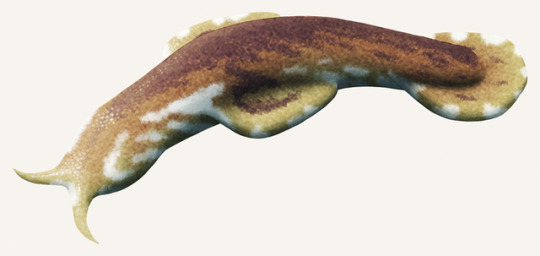
Unsolved Paleo Mysteries Month #10 -- Ambiguous Amiskwia
Amiskwia was a tiny soft-bodied creature from the Middle Cambrian, known from a fairly small number of fossils -- about 18 specimens from the Burgess Shale in Canada (505 mya) and an additional one from the Maotianshan Shales in China (515 mya).
Despite only measuring about 2.5cm long (1”), it was one of the larger animals alive at the time. Its body features a head with two tentacles and a small mouth, a pair of stubby fins, and a flattened paddle-shaped tail, suggesting it was an active swimmer. Its internal anatomy has been well-preserved in some specimens, revealing a brain, gut, and traces of what may be blood vessels and a nerve cord.
But we don’t know what type of animal it is. At all.
It was initially thought to be an early arrow worm. However, fossils of Cambrian representatives of that group have since been found, and Amiskwia lacks their characteristic spines and teeth. A relationship to ribbon worms or molluscs has also been suggested, but these hypotheses have the same problems with missing key features.
So, for now, Amiskwia remains one of the “weird wonders” of the Cambrian Explosion with no obvious affinities to any other known group.
[EDIT: Amiskwia seems to have finally been identified as a gnathiferan!]
#unsolved paleo mysteries month#science illustration#paleontology#paleoart#palaeoblr#amiskwia#cambrian explosion#burgess shale#weird wonders#incertae sedis#art
287 notes
·
View notes
Photo

Myllokunmingia fengjiaoa
Early Cambrian
Maotianshan Shale, Chengjiang biota, Yuanshan Fm (formerly Yuanshan Mbr, Qiongzhusi Fm) (Atdabanian)
Yunnan, China
Size: 3 cm
This chordate, known from a single specimen, might have been one of the earliest vertebrate. Some details of the animal, such as the location of the mouth or if it had eyes, are unknown.
illustration by Nobu Tamura
(via: Spinops - Nobu Tamura)
17 notes
·
View notes
Text
Trip to Maotianshan Mountain Shales
Trip to Maotianshan Mountain Shales
Maotianshan Mountain Shales has become one of the first national geological parks in China and a base of scientific study and travel. 帽天山动物化石群 Maotianshan Mountain Shales Located in the east of Chengjiang County, 8 kilometers from the seat of the county, Maotianshan Mountain looks like a big hat, hence the name. The mountain is famous for the ancient fauna fossils discovered by two biologists of…
View On WordPress
0 notes
Text
Período Cambriano
"
O Período Cambriano (541–485.4 milhões de anos) é o período conhecido pela explosão da vida na Terra, quando se originaram todos os principais filos de organismos multicelulares, e ocorreu a irradiação de quase todos os grupos que encontramos atualmente, em um período de tempo geologicamente curto.
Durante o Cambriano, os continentes estavam divididos em 3 porções de terra menores localizadas nos trópicos, e uma porção maior (o Gondwana) ao sul, e todos envoltos pelo oceano. As temperaturas que se elevaram a partir do final do Pré-Cambriano permaneceram estáveis durante todo o Cambriano.
//<![CDATA[ googletag.cmd.push(function() { googletag.display('dfp-arroba-meio1'); }); //]]>
Os locais onde afloram as rochas cambrianas contendo os fósseis deste período no mundo são raros, tendo como principais e mais conhecidos o Folhelho Burgess, no Canadá, o Folhelho de Maotianshan, na China, e os argilitos de Emu Bay, na Austrália.
As faunas desse período, embora primitivas, apresentavam inúmeros padrões morfológicos, uma imensa variedade de espécies, em sua maioria animais de corpo mole, e novas estratégias ecológicas, como a predação, enterrar-se profundamente no sedimento e construir túneis complexos e ramificados. Também apresentavam alguns animais esqueléticos relativamente grandes, como as trilobitas, braquiópodes, e o anomalocaris, um dos grandes predadores deste período.
//<![CDATA[ googletag.cmd.push(function() { googletag.display('dfp-arroba-meio2'); }); //]]>
Ilustração de alguns animais primitivos do Período Cambriano, incluindo o Anomalocaris (centro). Ilustração: Dotted Yeti / Shutterstock.com
Explosão Cambriana: a grande biodiversidade da fauna
As faunas fósseis que representam a explosão da vida nos mares durante o Cambriano são a Tommotiana, a de Chengjiang, e a do Folhelho Burgess.
A Fauna Tommotiana (em inglês small shelly fauna) representa o conjunto de fósseis que existiram logo no início do período Cambriano, há cerca de 570-560 milhões de anos. É caracterizada por uma fauna fóssil de pequenos animais de conchas, representando os primeiros metazoários com partes duras preservadas. Seus fósseis são encontrados em afloramentos principalmente na Rússia, entre outros locais do mundo, e abrange uma grande quantidade de pequenos fósseis de corpos duros (esqueléticos), como conchas, cones, tubos, espículas, moluscos, braquiópodes, esponjas, anelídeos, os extintos arqueociatídeos (primeiros animais formadores de recifes), entre outros.
A Fauna Chengjiang (520 milhões de anos, Cambriano Inferior) ocorre principalmente em afloramentos de Folhelhos Maotianshan, na China, conhecidos por conter todos os grupos fósseis encontrados na fauna do Folhelho Burgess, evidenciando a diversificação dos metazoários ainda no Cambriano Inferior. A fauna é caracterizada por organismos de corpo mole, bem preservados, e composta por 185 espécies de esponjas a cordados e 60 artrópodes, tais como o Anomalocáridus, Hallucigenia, Wiwaxia, Opabinia, trilobitas, entre outros.
A Fauna do Folhelho Burgess ou Burgess Shale (510 milhões de anos, Cambriano Médio) são os fósseis de animais invertebrados mais importante do mundo, pois registra um dos acontecimentos cruciais da história da vida na Terra: o resultado do processo de diversificação que ocorreu logo após o período de explosão da vida na Terra (explosão Cambriana). As rochas contendo esta fauna fóssil afloram em rochas canadenses, e contém fósseis de organismos de corpo mole preservados nos mínimos detalhes. A fauna evoluiu bastante desde a ocorrência da fauna anterior (a fauna de Chengjiang), sendo caracterizada por organismos invertebrados, sem partes resistentes fossilizáveis, e sem correspondentes com organismos da atualidade. É composta por 140 espécies distribuídas em 119 gêneros, quase um gênero por espécie, contendo artrópodes diversos (14 gêneros de trilobitas), 30 outros artrópodes (transicionais entre trilobitas e crustáceos), celenterados, medusóideos, polipóideos, anelídeos variados e equinodermos holotúróideos.
Figura 2. Vista de um afloramento do Folhelho Burguess no topo das Rock Montains canadenses, Yoho National Park. Foto: NorthStarPhotos / Shutterstock.com
Como surgiu a vida nos mares do período Cambriano
As principais condições que geraram a explosão da vida e da diversidade durante o Cambriano foram a falta de predadores nos mares, pois estes estavam originando-se e desenvolvendo-se junto a todos os outros organismos, o aparecimento de pequenos esqueletos biomineralizados (conchas e recifes), e principalmente, as mudanças geoquímicas nos mares, devido ao aumento da temperatura global e do oxigênio na Terra, liberado pelos recifes.
Impressão de uma trilobita fóssil, do Burgess Shale. Foto: inEthos Design / Shutterstock.com
Referências:
TEIXEIRA, W.; FAIRCHILD, T.; TOLEDO, M.C.M. & TAIOLI, F. (2007). Decifrando a Terra. 2ª edição, São Paulo, SP; Companhia Editora Nacional, 623p.
PRESS, F.; SIEVER, R.; GROTZINGER, J. e JORDAN, T.H. (2013). Para entender a Terra. Tradução R. Menegat (coord.), 6ª edição, Porto Alegre, RS; Bookman, 656p.
http://agencia.fapesp.br/explosao-de-vida/9893/
http://www.cprm.gov.br/publique/Redes-Institucionais/Rede-de-Bibliotecas---Rede-Ametista/Canal-Escola/Breve-Historia-da-Terra-1094.html
http://www.scotese.com/climate.htm
http://labs.icb.ufmg.br/lbem/aulas/grad/evol/especies/preposcambriano.html
Hou, X., and Bergström, J. 2003. The Chengjiang fauna – the oldest preserved animal community. Paleontological Research, v.7(1):55-70.
The post Período Cambriano appeared first on InfoEscola.
InfoEscola https://ift.tt/2ZLTrrN
Publicado primeiro em https://www.infoescola.com"
Este conteúdo apareceu primeiro em: https://ift.tt/2w0BWWY
0 notes